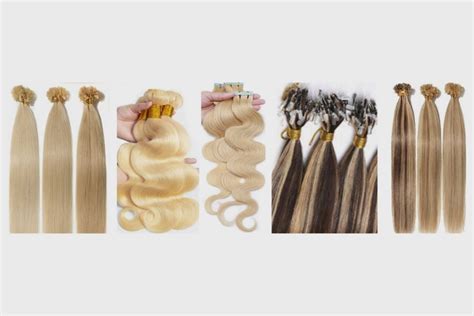Transforming your hairstyle with hair extensions has become increasingly popular, allowing individuals to experiment with various lengths, volumes, and colors. With a plethora of options available, selecting the ideal type of extension can be a daunting task. This comprehensive guide explores the different types of hair extensions, highlighting their properties, benefits, and drawbacks to empower you with the knowledge to make an informed decision.

Permanent vs. Temporary Hair Extensions
The primary distinction between hair extensions lies in their attachment method. Permanent hair extensions remain attached to your natural hair for an extended period, while temporary hair extensions can be applied and removed with ease.
Permanent Hair Extensions
Tape-in Extensions: Thin, adhesive-backed wefts of hair are applied to your natural hair using a heat-resistant tape. Tape-in extensions provide an instant, seamless blend and last for 4-8 weeks.
Fusion Extensions: Individual strands of hair are attached to keratin-filled beads and fused to your natural hair using a heat tool. Fusion extensions seamlessly blend with your hair and can last for up to 6 months.
Beaded Extensions: Similar to fusion extensions, beaded extensions attach individual strands of hair to your natural hair using small metal beads. However, no heat is required for application, minimizing potential damage.
Temporary Hair Extensions
Clip-in Extensions: Convenient and affordable, clip-in extensions are attached to your hair using pressure-sensitive clips. They offer versatility and instant hair transformations, but can be visible if not properly applied.
Halo Extensions: A flexible band with an attached hairpiece, halo extensions rest comfortably around your head, blending naturally with your hair. They are quick and easy to apply, lasting for several hours.
Weave Extensions: Tracks of hair are sewn onto thin cornrows or braids created in your natural hair. Weave extensions provide volume and length but require regular maintenance and can be time-consuming to apply.
Human Hair vs. Synthetic Hair Extensions
Another key factor to consider is the material used in hair extensions.
Human Hair Extensions
Remy: Consisting of real human hair with the cuticle intact, Remy extensions have a natural look and feel. They can be styled with heat tools and last for a longer duration.
Non-Remy: While still human hair, Non-Remy extensions may have the cuticles removed, resulting in potential tangling and matting. They are generally less expensive than Remy extensions.
Synthetic Hair Extensions
High-Heat Synthetic: Made from heat-resistant fibers, these extensions can withstand heat styling up to 280°F. They offer versatility and affordability but may appear less natural than human hair.
Low-Heat Synthetic: Limited to styling with heat tools below 180°F, low-heat synthetic extensions are typically more affordable and require less maintenance. However, they may not offer the same longevity as human hair extensions.
Factors to Consider When Choosing Hair Extensions
Hair Type: Match the extension type to your natural hair texture for a seamless blend.
Desired Length and Volume: Determine the length and volume you desire to achieve.
Styling Preference: Consider whether you want to style your extensions with heat tools.
Budget: Hair extensions vary in price depending on the type, material, and method of application.
Pain Points: Identify any discomfort, damage, or visibility issues associated with different hair extensions.
Motivations: Define your reasons for considering hair extensions, whether for aesthetics, special occasions, or confidence enhancement.
Common Mistakes to Avoid
Over-Styling: Excessive heat styling can damage hair extensions, reducing their lifespan.
Improper Application: Incorrect attachment techniques can compromise the longevity and natural appearance of extensions.
Neglecting Maintenance: Neglecting regular washing, brushing, and conditioning can lead to tangles, matting, and reduced quality.
Color Mismatches: Ensure the color of the extensions complements your natural hair to achieve a seamless blend.
Conclusion
Selecting the ideal type of hair extensions requires careful consideration of your individual needs, preferences, and budget. By understanding the different types of hair extensions, their properties, and the factors to consider, you can make an informed decision that will enhance your hairstyle and elevate your confidence. Remember to prioritize proper application and maintenance to ensure the longevity and natural appearance of your extensions.
